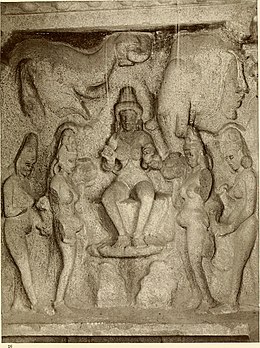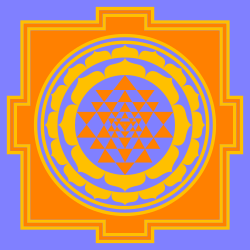Lakshmi Tantra
Topic: Religion
 From HandWiki - Reading time: 5 min
From HandWiki - Reading time: 5 min
The Lakshmi Tantra (Sanskrit: लक्ष्मीतन्त्र, romanized: Lakṣmītantra) is one of the Pancharatra texts that is dedicated to the goddess Lakshmi and Narayana (Vishnu) in Hinduism. It forms a part of the Agamas. The Lakshmi Tantra is devoted to the worship of the goddess Lakshmi (the shakti of Vishnu-Narayana), although it also glorifies all women in general.[1]
Date
The text was composed sometime between the ninth and twelfth centuries.[2]
Contents
The Lakshmi Tantra text includes information about Pancharatra philosophy, cosmogony and mantra sastra. The iconography for Lakshmi-Narayana and Vishnu’s Vyūhas is also discussed. The book does not include information about ritualistic worship, temple architecture and worship.[3]
The text may also be categorised as Vaishnava, since it glorifies Lakshmi-Narayana as supreme:[4]
Sakra: — O Goddess, who appearest from the milky ocean, wife of the God Padmanabha, I prostrate myself before Thee, who art lotus-born. Deign to explain who a living being is.
Sri: — The primordial, absolute I-hood of Hari is myself and I am the transcendental, supreme Goddess.
The Lakshmi Tantra is shown to have distinct similarities with the Pratik Rahasyam of Devi Mahatmya, showing an assimilation of Vaishnavas with Shakta-lore, which is extremely rare. The episode describing how the Supreme Shakti, Adi Mahalakshmi, transforms into her complete incarnation, Mahalakshmi or Mahasri, who is shown holding a mace, a shield, a citron, and a bowl. She is golden in colour, and on her crown she holds a lingam and a multi-headed snake which symbolizes the Trideva; linga meaning Shiva, yoni meaning Vishnu, and the snake representing Brahma. She represents the rajas guna. From here it is quite similar to what is seen in the Pratik Rahasyam, Mahalakshmi creates Mahakali/Mahamaya and Mahasaraswati/Mahavidya who represent the tamas guna and satva guna, respectively. However, unlike in the Pratika Rahasyam, where the Devis create the Trimurti and the Tridevi on their own, in the Lakshmi Tantra, Adi Purusha, or Parama Vasudeva, creates three of the Chaturvyuha, Pradyumna, Aniruddha, and Sankarshana. Pradyumna is linked with Mahasri, who create Brahma and Lakshmi (named as Padma), Sankarshana is linked with Mahamaya, creating Shiva and Saraswati, and Aniruddha and Mahavidya are linked together, creating Vishnu and Gauri/Parvati. Here, the union of male and female energies link to create srishti, or life.[5][6]
The text precisely expounds the specifics of the philosophy of qualified monism Vishishtadvaita, but it is also observed that it is much inspired from the philosophy of Pratyabhijna of Kashmiri Shaivism propounded by Abhinavagupta. The text also reveals traces of Mahayana Buddhism. The influence of the Bhagavad Gita is also clearly apparent and passages from it have sometimes been quoted literally.[7]
Manifestations
The Lakshmi Tantra discusses the various avataras, or the descents, of the goddess, when Narayana incarnates on earth, to perform her anuvrata, or functions. These descents are called the six sheaths, and are categorised as possessing one form, two forms, four forms, six forms, eight forms, as well as twelve forms:[8]
- Mahālakṣmī, as the first manifestation of the Goddess
- Śri and Puṣṭi, as two manifestations on either side of Narayana
- Śri, Kīrti, Jayā, and Māyā, as four manifestations around Narayana
- Śuddhi, Nirañjana, Nityā, Jñānaśakti, Aparājitā, and Prakṛti as six manifestations, in a hexagonal position
- Lakṣmī, Sarasvatī, Sarvakāmadā, Prītivardinī, Yaśaskarī, Śāntidā, Tuṣṭida, and Puṣṭi, as eight manifestations
- Śri, Kāmeśvarī, Kānti, Kriyā, Śakti, Vibhūti, Icchā, Prīti, Ratī, Māyā, Dhī, and Mahiman, as twelve manifestations, in a double hexagonal position
In the Dashavatara and the other incarnations of Vishnu, Lakshmi appears as Bhudevi for Varaha, Bhargavi for Dattatreya, Padma for Vamana, Dharani for Parashurama, Sita for Rama, Revati for Balarama, Rukmini for Krishna, Rati for Pradyumna, Usha for Aniruddha, and Tara for Buddha.[citation needed]
References
- ↑ www.wisdomlib.org (2021-09-19). "Lakshmi-tantra [sanskrit"] (in en). https://www.wisdomlib.org/hinduism/book/lakshmi-tantra-sanskrit.
- ↑ Lakṣmī Tantra. A Pāñcarātra text. Internet Archive. Leiden, : Brill. 1972. pp. 21. ISBN 978-90-04-03419-8.
- ↑ Gupta, Sanjukta. Lakshmi Tantra A Pancharatra Text. pp. XVII. http://archive.org/details/LakshmiTantraAPancharatraTextSanjuktaGupta.
- ↑ Lakshmi Tantra A Pancharatra Text Sanjukta Gupta. pp. 37. http://archive.org/details/LakshmiTantraAPancharatraTextSanjuktaGupta.
- ↑ "Lakshmi Tantra" (in en). http://vedicgoddess.weebly.com/3/post/2013/01/lakshmi-tantra-by-yogi-ananda-saraswathi.html.
- ↑ Pattanaik, Devdutt. "The ancient story of goddess Lakshmi—bestower of power, wealth and sovereignty" (in en). https://qz.com/india/545655/the-ancient-story-of-goddess-lakshmi-bestower-of-power-wealth-and-sovereignty/.
- ↑ Gupta, Sanjukta (2000-01-01) (in en). Laksmi Tantra: A Pancaratra Text. Motilal Banarsidass. ISBN 978-81-208-1734-0. https://books.google.com/books?id=dNriDwAAQBAJ.
- ↑ Lakshmi Tantra A Pancharatra Text Sanjukta Gupta. pp. 46 - 47. http://archive.org/details/LakshmiTantraAPancharatraTextSanjuktaGupta.
| Part of a series on |
| Hindu scriptures and texts |
|---|
 |
| Related Hindu texts |
 |
 KSF
KSF

